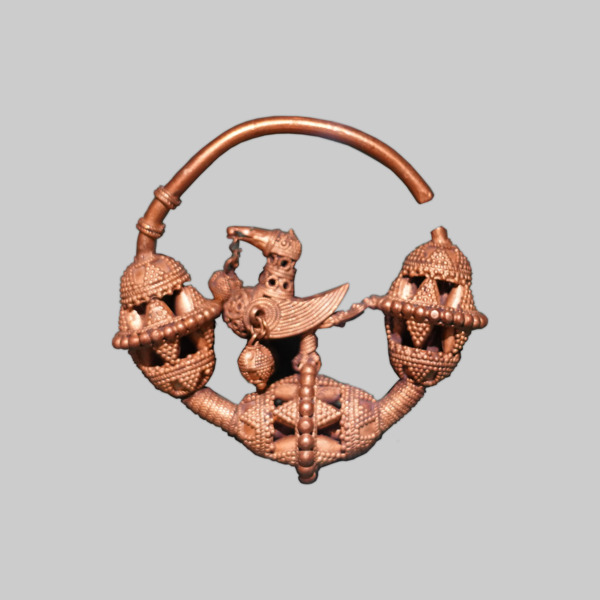Female temple decoration in the form of a ring with a duck is a masterpiece of the Volga Bulgarians’ jewellery craft. The pendant was made of 999 gold and its total weight was 102 grams. Researchers dated it to the 11th century — the first half of the 13th century.
The item was found in 1998, but the exact location of the discovery is unknown. Scientists compared the finding with other Bulgarian temple ornaments and concluded that it belonged to the era of the Bulgarian state in the Middle Volga region. Pendants with the duck figurine were a classic of jewellery making in the region. They were made of gold and intended for the wealthy Bulgars. The items were worn in pairs, attached to the headdress at the temples, or woven into the hair.
The pendant consists of a ring on which three beads are strung. In the centre there is a small duck figurine, the wings and neck of which are covered with filigree — a pattern of gold wire. The craftsman adorned the item with grit — gold balls with a diameter of 0.01 to 2 millimetres. In total, more than 1,500 such balls were used in the manufacture of the decoration. The ring lacks a traditional element — pendant beads on chains. Perhaps they were originally part of the item — this is evidenced by the through holes in the grain ring of the lower false bead.
The exhibit item from the museum differs from traditional Bulgar products: it is larger in size, and its bow was made using a different technology. The proportions of the bird figurine are also not typical for the decorations of the Middle Volga region. The researchers explained the differences by the fact that the craftsman had his own individual approach.
The piece of jewellery was associated with the mythological and cultural heritage of the Turkic world. The decoration referred to the ancient story of a duck that flew through the air, swam in the water and moved over land. The bird personified the high sky, the firm land and the depths of water. Legend has it, that it was the duck that brought the first piece of land from under the water, from which the land was subsequently formed and the world arose. According to the famous ethnographer Aleksandr Zolotarev, this belief arose in Asia among the Mongoloid tribes. Variants of the myth were found among the Slavic, Finno-Ugric and Turkic peoples.
The item was found in 1998, but the exact location of the discovery is unknown. Scientists compared the finding with other Bulgarian temple ornaments and concluded that it belonged to the era of the Bulgarian state in the Middle Volga region. Pendants with the duck figurine were a classic of jewellery making in the region. They were made of gold and intended for the wealthy Bulgars. The items were worn in pairs, attached to the headdress at the temples, or woven into the hair.
The pendant consists of a ring on which three beads are strung. In the centre there is a small duck figurine, the wings and neck of which are covered with filigree — a pattern of gold wire. The craftsman adorned the item with grit — gold balls with a diameter of 0.01 to 2 millimetres. In total, more than 1,500 such balls were used in the manufacture of the decoration. The ring lacks a traditional element — pendant beads on chains. Perhaps they were originally part of the item — this is evidenced by the through holes in the grain ring of the lower false bead.
The exhibit item from the museum differs from traditional Bulgar products: it is larger in size, and its bow was made using a different technology. The proportions of the bird figurine are also not typical for the decorations of the Middle Volga region. The researchers explained the differences by the fact that the craftsman had his own individual approach.
The piece of jewellery was associated with the mythological and cultural heritage of the Turkic world. The decoration referred to the ancient story of a duck that flew through the air, swam in the water and moved over land. The bird personified the high sky, the firm land and the depths of water. Legend has it, that it was the duck that brought the first piece of land from under the water, from which the land was subsequently formed and the world arose. According to the famous ethnographer Aleksandr Zolotarev, this belief arose in Asia among the Mongoloid tribes. Variants of the myth were found among the Slavic, Finno-Ugric and Turkic peoples.



